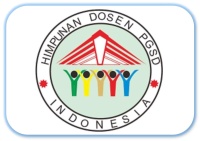Peningkatan Hasil Belajar Volume Bangun Ruang dengan Model Problem Based Learning di Kelas V Sekolah Dasar
Abstract
This research is motivated by the low results of studying the volume of geometric shapes and the relationship of cubes and cube roots. The purpose of this study was to describe the increase in spatial volume learning outcomes with the Problem Based Learning model in Class V SDN 12 Padang Besi, Padang City. This type of research is Classroom Action Research using qualitative and quantitative approaches. The research procedures are planning, implementing, observing, and reflecting. Data collection techniques in the form of observation, tests and non-tests. The research subjects were teachers as observers, researchers as practitioners, and 25 fifth-grade students. The results showed that the lesson plan for cycle I obtained an average of 86.46% (B), and an increase in cycle II of 93.75% (SB). Implementation of the first cycle of the teacher aspect obtained an average of 86.9% (B), increased in the second cycle by 96.42% (SB). Implementation of the first cycle aspects of students obtained an average of 83.33% (B), increased in the second cycle to 92.85% (SB). The learning outcomes of the first cycle obtained an average of 73.66 (C), increased in the second cycle to 86.01 (B). It was concluded that the use of the Problem-Based Learning model could improve the learning outcomes of geometric volumes and cube and cube roots in Class V SDN 12 Padang Besi
Keywords
Full Text:
PDFReferences
Arta, I. M., Japa, I. G. N., & Sudarma, I. K. (2020). Problem Based Learning Berbantuan Icebreaker Berpengaruh Terhadap Kemampuan Pemecahan Masalah Matematika. MIMBAR PGSD Undiksha, 8(2), 264-273.
Fathurrohman, M. (2016).Model-Model Pembelajaran Inovatif. Yogyakarta: Ar-Ruzz Media.
Hamruni. 2012. Strategi Pembelajaran. Yogyakarta: Insan Madani
Hosnan. (2014). Pendekatan Saintifik dan Kontekstual dalam Pembelajaran. Jakarta: Ghalia Indonesia.
Kohar, Fatoni, & Satiti. (2012). How many more cake boxes are needed to fulfill the cardboard boxes?.A Description of Learning Volume of Cuboid and Cube at Grade 5C SD N 1 Palembang. Palembang: Pascasarjana Universitas Sriwijaya.
Maulana, D. (2015). Ragam Model Pembelajaran di Sekolah Dasar Edisi Kedua. UPI Sumedang Press.
Merantika, J., & Lena, M. S. (2021). Peningkatan Hasil Belajar Tematik Terpadu dengan Pendekatan Value Clarification Technique (Vct) Model Matriks di SD. JKPD (Jurnal Kajian Pendidikan …, 6.
Nisak, F., & Yulkifli, Y. (2021). Development of electronic module using inquiry based learning (IBL) model integrated high order thinking skill (HOTS) in 21stcentury physics learning class X. Journal of Physics: Conference Series, 1876(1), 1–9. https://doi.org/10.1088/1742-6596/1876/1/012085
Nasir, M., Wagino, & Pasaribu. (2017). Peningkatan Prestasi dan Aktivitas Belajar Peserta Didik Pada Pembelajaran Alat Ukur Mekanik Menggunakan Model Problem Based Learning. Journal Inovasi, Vokasional, Dan Teknolohi, 17 (02), 53 – 60.
Prastowo, Andi. 2017. Menyusun Rencana Pelaksanaan Pembelajaran (RPP) Tematik Terpadu Implementasi Kurikulum 2013 untuk SD/MI. Jakarta: Kencana
Kunandar. (2016). Langkah Mudah Penelitian Tindakan Kelas Sebagai Pengembangan Profesi Guru. PT Raja Grafindo.
Purwanto. (2017). Evaluasi Hasil Belajar. Pustaka Pelajar.
Ramlawati.,Yunus, S. R., &Insani, A. 2017. Pengaruh Model PBL (Problem Based Learning) terhadap Motivasi dan Hasil Belajar IPA Peserta Didik. Jurnal Sainsmart. (Volume 6 Nomor 1), 5-6, diakses pada tanggal 6 Oktober 2021.
Rosidah, C. T. 2018. Penerapan model problem based learning untuk menumbuhkembangkan higher order thinking skill siswa sekolah dasar. Jurnal Inventa Vol II. No 1 Maret 2018 ISSN 2598-6244, 62- 71.
Sani, Ridwan Abdullah. 2019. Strategi Belajar Mengajar. Depok: PT Raja Grafindo Persada.
DOI: http://dx.doi.org/10.24036/e-jipsd.v12i2.14643


